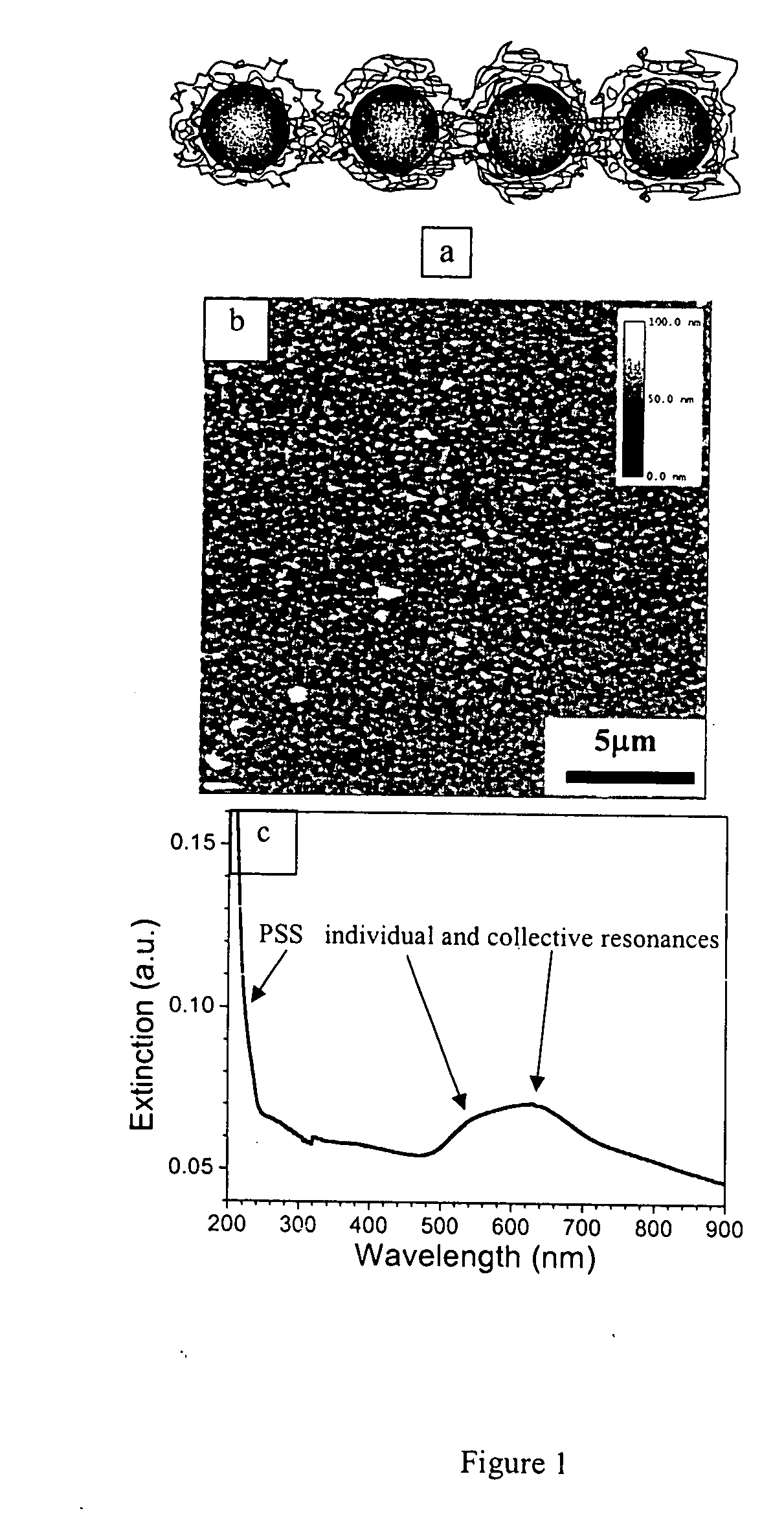Compliant, nanoscale free-standing multilayer films
a free-standing, nano-scale technology, applied in the direction of nuclear engineering, instruments, membranes, etc., can solve the problems of nanoparticle containing, extremely fragile thin lbl films, and the approach used to fabricate multi-layered cannot be fully functional, so as to enhance the optical response
- Summary
- Abstract
- Description
- Claims
- Application Information
AI Technical Summary
Benefits of technology
Problems solved by technology
Method used
Image
Examples
example 1
[0039] Gold nanoparticle-polymer multilayer films of the general formula (PAH-PSS)nPAH / Au / (PAH-PSS)nPAH which comprise a central gold nanoparticle layer covered with polymer multilayers (n=3-11) were fabricated by SA-LbL method (FIGS. 4a-b).
[0040] Gold nanoparticles (12.7±1.3 nm in diameter) were synthesized according to the known procedure.[24] Resulting gold nanoparticles are slightly negatively charged and can be used for electrostatic LbL assembly as was demonstrated elsewhere.[25] Polyelectrolytes, poly(ethylene imine) (PEI Mw=25,000), poly(allylamine hydrochloride) (PAH, Mw=65,000), and poly(sodium 4-styrenesulfonate) (PSS, Mw=70,000) were purchased from Aldrich and used as received. For SA-LBL deposition, PEI (1%), PAH (0.2%), and PSS (0.2%) solution were prepared with Nanopure water (18MΩ·cm). Silicon wafers with typical size 10×20 mm were immersed in piranha solution for 30 minutes and then rinsed throughout with pure water before used according to the usual procedure.[26]...
example 2
S
[0101][4]. Fendler, J. H. Chem. Mater. 2001, 13, 3196. [0102][14]. Félidj, N.; Aubard, J.; Lévi, G.; Krenn, J. R.; Salerno, M.; Schider, G.; Lamprech, B.; Leitner, L. A.; Aussenegg, F. R. Phys. Rev. B 2002, 65, 075419. [0103][16]. Caruso, F.; Spasova, M.; Salgueiriño-Maceira, V.; Liz-Marzán, L. Adv. Mater. 2001, 13, 1090; Westcott, S. L.; Oldenburg, S. J.; Lee, T. R.; Halas, N. J. Langmuir 1998, 14, 5396; Gittins, D. I.; Caruso, F. J. Phys. Chem. B 2001, 105, 6846. [0104][17]. Schmitt, J.; Decher, G.; Dressick, W. J.; Brandow, S. L.; Geer, R. E.; Shashidhar, R.; Calvert, J. M. Adv. Mater. 1997, 9, 61. [0105][25]. Decher, G. Science 1997, 277, 1232; Lvov, Y.; Ariga, K.; Ichinose, I.; Kunitake, T. J. Am. Chem. Soc. 1995, 117, 6117; Lvov, Y.; Decher, G.; Möhwald, H. Langmuir 1993, 9, 481; Decher, G.; Lvov, Y.; Schmitt, J. Thin Solid Films 1994, 244, 772; Lvov, Y.; Decher, D. Crystallography Reports, 1994, 39, 628. [0106][28]. Rechberger, W.; Hohenau, A.; Leitner, A.; Krenn, J. R.; Lam...
PUM
| Property | Measurement | Unit |
|---|---|---|
| thickness | aaaaa | aaaaa |
| thickness | aaaaa | aaaaa |
| diameter | aaaaa | aaaaa |
Abstract
Description
Claims
Application Information
 Login to View More
Login to View More - R&D
- Intellectual Property
- Life Sciences
- Materials
- Tech Scout
- Unparalleled Data Quality
- Higher Quality Content
- 60% Fewer Hallucinations
Browse by: Latest US Patents, China's latest patents, Technical Efficacy Thesaurus, Application Domain, Technology Topic, Popular Technical Reports.
© 2025 PatSnap. All rights reserved.Legal|Privacy policy|Modern Slavery Act Transparency Statement|Sitemap|About US| Contact US: help@patsnap.com



